To understand roofing lingo, grasp terms like Roof Pitch for slope determination and Eaves for water runoff. Explore Valley for construction insight and Flashing's waterproofing role. Understand the importance of Underlayment for leak defense and Drip Edge for shingle protection. Learn about Ice Dam formation and prevention tips. Enhance aesthetics with Fascia and comprehend how Ridge Vent aids ventilation. Mastering these terms guarantees informed decisions on roof care.
Roof Pitch
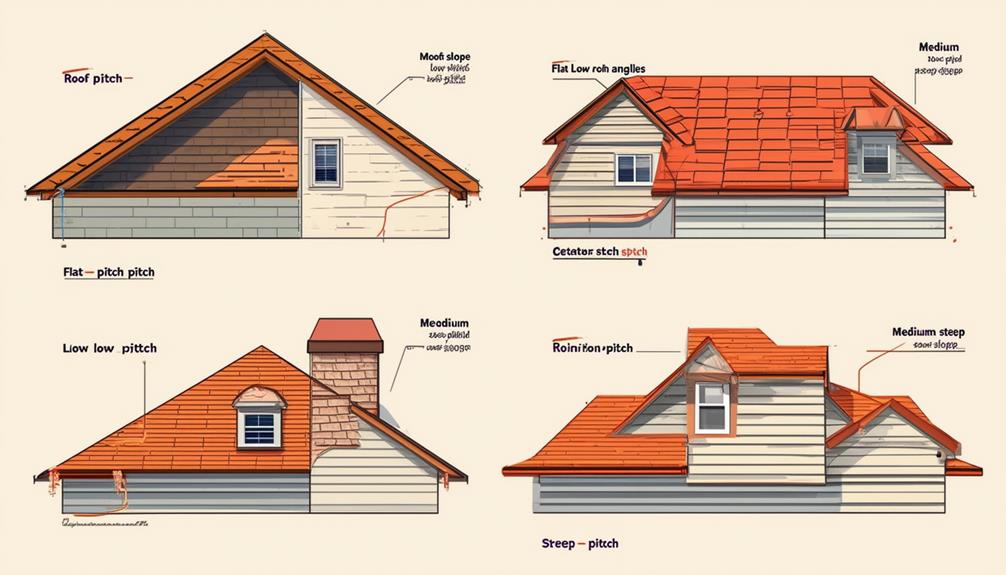
Understanding the roof pitch is crucial in determining the slope and angle of your roof. Roof pitch calculation involves measuring the vertical rise of the roof in relation to its horizontal span. Common misconceptions often revolve around the belief that roof pitch only affects the aesthetics of a building. In reality, the roof pitch plays a critical role in determining the type of roofing materials that can be used, as well as affecting factors such as drainage and snow load capacity.
When considering roof pitch aesthetics and design considerations, it's crucial to highlight that steeper pitches are not only visually appealing but also offer practical benefits. Higher pitch angles enhance water runoff efficiency, preventing water pooling which can lead to leaks or structural damage. Additionally, steep roof pitches can provide additional living or storage space in the form of attic rooms or vaulted ceilings. Hence, when planning your roof design, carefully consider the ideal pitch that balances both aesthetic appeal and functionality.
Flashing
To guarantee proper waterproofing and prevent water intrusion in your roofing system, flashing plays a vital role in sealing joints and connections between different roof components. There are various types of flashing used in roofing, including step flashing, counter flashing, and continuous flashing. Each type serves a specific purpose in ensuring water tightness at vulnerable points like chimneys, skylights, and roof edges.
Proper installation of flashing is essential to its effectiveness. Flashing should be securely fastened and integrated into the roofing system to create a seamless barrier against water infiltration. Attention to detail during installation is key to preventing future leaks and maintaining the integrity of the roof.
Regular maintenance of flashing is important to extend its lifespan and prevent potential water damage. Inspecting flashing for signs of damage, such as cracks or rust, and promptly addressing any issues through repairs or replacements can help uphold the protective function of the flashing system. By staying proactive with flashing maintenance, you can ensure the long-term durability and reliability of your roof.
Eaves
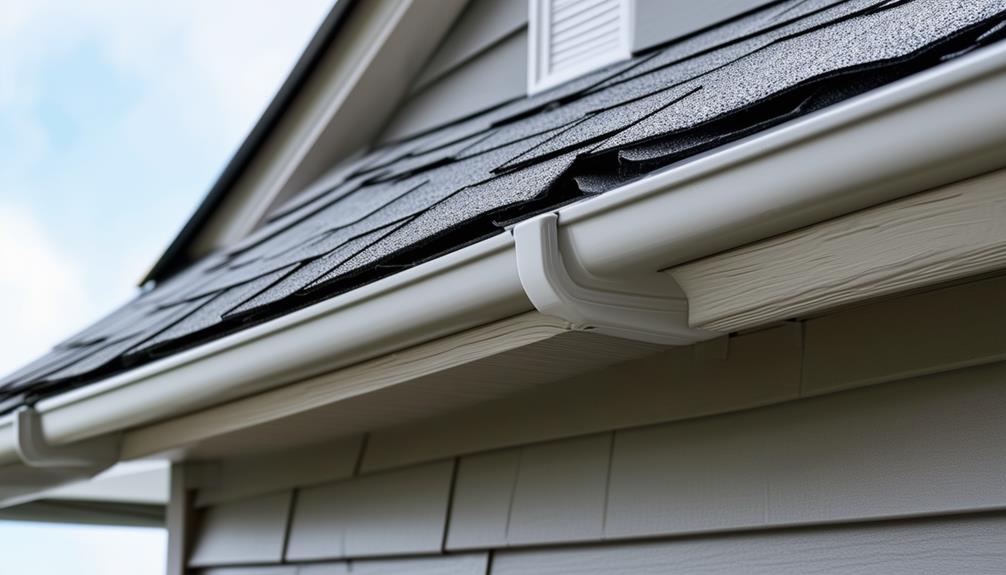
The eaves of a roof refer to the horizontal edges that overhang the building's walls, providing protection from water runoff and directing it away from the structure. When it comes to eaves design, it is important to guarantee they have the proper slope to effectively channel water away from the building. Regular maintenance is essential to prevent issues such as water damage or rot. Inspect the eaves for any signs of damage, such as cracks or holes, and promptly repair them to maintain their functionality.
Eaves come in various color options and material choices to complement the overall aesthetic of the building. Popular materials for eaves include vinyl, aluminum, wood, and steel. Each material offers different levels of durability and requires specific maintenance routines. Consider the climate of your area when selecting eaves material to ensure it can withstand the local weather conditions. Regularly cleaning and repainting eaves can help prolong their lifespan and keep them looking fresh.
Underlayment
Underlayment serves as an essential layer beneath roofing materials, providing additional protection against water infiltration and enhancing the roof's overall durability. There are various types of underlayment available, with the most common being asphalt-saturated felt, synthetic underlayment, and rubberized asphalt membrane. Asphalt-saturated felt, also known as tar paper, is cost-effective and offers good water resistance. Synthetic underlayment, made from polypropylene or polyethylene, is lightweight, resistant to tearing, and provides excellent traction for roofers during installation. Rubberized asphalt membrane underlayment is self-adhering, creating a watertight seal and offering superior protection against water intrusion.
When it comes to underlayment installation techniques, ensuring proper overlap and alignment is vital to prevent water penetration. The underlayment should be securely fastened to the roof deck, with special attention given to valleys, edges, and penetrations. Properly installed underlayment acts as a secondary defense against leaks, safeguarding the roof structure and interior of the building from moisture damage.
Fascia
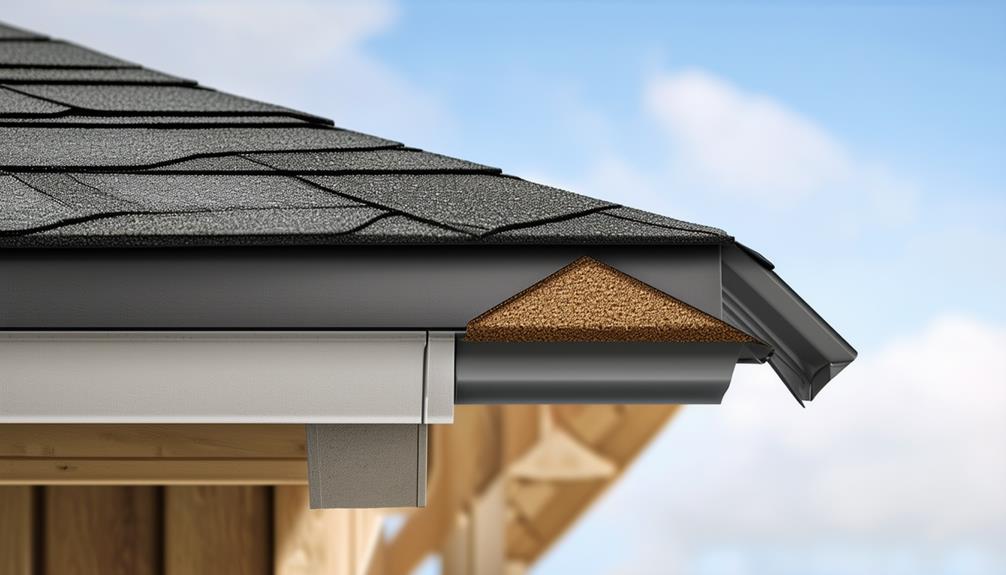
When constructing a roof, fascia plays an important role in providing a clean, finished look to the edges of the roof structure. Fascia acts as a protective barrier between the edge of the roof and the outdoor elements, preventing water damage and offering structural support. Proper fascia maintenance is vital to guarantee the integrity of your roof. Regular inspections for signs of rot, peeling paint, or damage are essential. If repairs are needed, addressing them promptly can prevent more extensive issues down the line.
When it comes to fascia material options, there are several choices available. Wood fascia provides a traditional look but requires regular maintenance to prevent rot and decay. Aluminum fascia is a popular alternative due to its durability and low maintenance requirements. PVC and composite fascia boards are also options that offer durability and resistance to moisture and insects. Selecting the right fascia material for your roof can enhance its overall appearance and longevity.
Soffit
Soffit, also known as eaves or ceiling board, is an essential component of the roofing system that plays an important role in providing ventilation and aesthetics to your home. Soffit ventilation is essential for maintaining proper air circulation in your attic, preventing moisture buildup, and enhancing energy efficiency. To guarantee effective ventilation, regularly inspect and clean the soffit vents to remove any debris that may obstruct airflow. Additionally, consider installing insect screens to prevent pests from entering through the vents.
When it comes to soffit material options, you have a variety to choose from, including vinyl, aluminum, wood, and fiber cement. Each material offers different benefits in terms of durability, maintenance requirements, and aesthetics. Select a material that complements your home's design while meeting your functional needs.
For design ideas, you can opt for a ventilated soffit that combines functionality with style. Incorporating different patterns or colors can add visual interest to your home's exterior. Remember to maintain your soffit by regularly cleaning, inspecting for damage, and addressing any issues promptly to prolong its lifespan and keep your home looking its best.
Ridge Vent
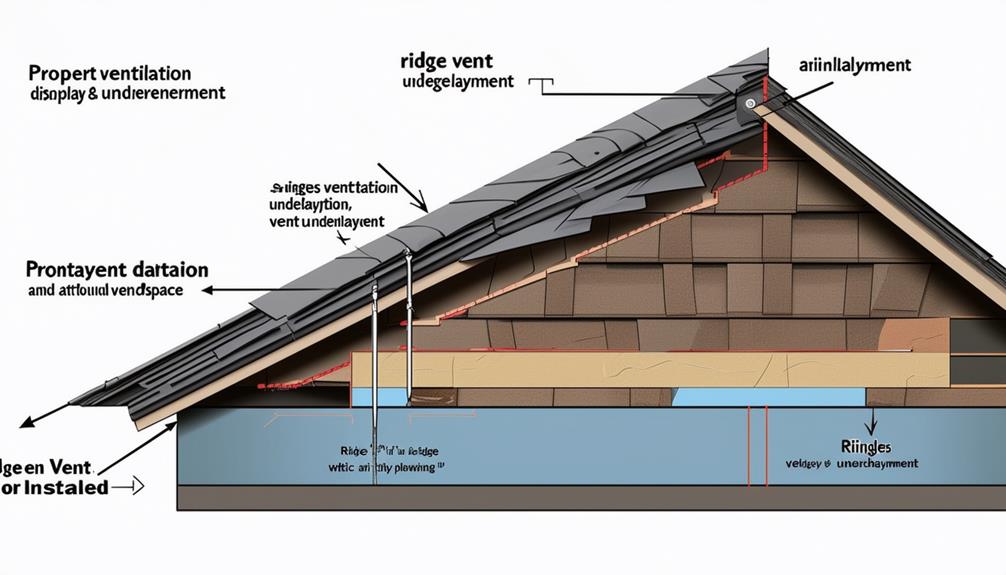
In a roofing system, the ridge vent is a key component that serves as an important element for proper attic ventilation. Ventilation systems in a home are vital for maintaining a healthy environment and extending the lifespan of roofing materials. The ridge vent is a type of vent installed at the peak of a sloped roof, allowing warm, moist air to escape from the attic. Its design maximizes airflow efficiency, making it one of the most effective ventilation solutions available.
When considering roofing materials, durability is a significant factor to contemplate. Ridge vents are typically made from durable materials such as metal or high-grade plastics to ensure longevity and resistance against harsh weather conditions. Proper installation of a ridge vent enhances its effectiveness in ventilating the attic space, preventing moisture buildup and potential damage to the roof structure.
To optimize the performance of your roof's ventilation system, making sure the ridge vent is correctly installed and free from obstructions is essential. Regular maintenance and inspection can uphold the longevity and effectiveness of the ridge vent in your roofing system.
Drip Edge
When it comes to roofing, understanding the purpose of a drip edge is vital. This essential component helps to direct water away from the roof and into the gutters, preventing potential water damage. Proper installation of the drip edge is key to ensuring its effectiveness in protecting your roof structure.
Purpose of Drip Edge
To understand the purpose of the drip edge in roofing, you need to recognize its critical role in directing water away from the roof's edge. The drip edge is an essential component that offers various benefits related to water protection and the proper installation of roof shingles. Here are some key points to keep in mind:
- Water Protection: The primary function of the drip edge is to prevent water from seeping into the underlying structures by directing it away from the edge of the roof.
- Roof Shingle Installation: By providing a neat and straight edge for the first row of shingles, the drip edge ensures a more secure and professional installation.
- Installation Process: Properly setting up the drip edge involves securing it along the eaves and rakes before any shingle installation to maximize its effectiveness.
- Overhang Importance: The overhang created by the drip edge plays a critical role in protecting the roof deck and fascia from water damage, ultimately extending the lifespan of the roof.
Installation Tips
Properly align the drip edge along the eaves and rakes to guarantee ideal water diversion and protection during the roofing installation process. When installing the drip edge, make sure you follow essential safety precautions. Use appropriate personal protective equipment such as gloves and safety glasses. Selecting the right tools is vital for a successful installation. Have a hammer, roofing nails, and tin snips on hand for efficient work.
Consider weather conditions before starting the installation. It's best to install the drip edge on a dry day to prevent any slipping accidents. When it comes to material choices, opt for durable options like galvanized steel or aluminum, which offer longevity and resistance to corrosion. These materials provide a secure barrier against water infiltration and protect the fascia and roof deck from moisture damage.
Ice Dam
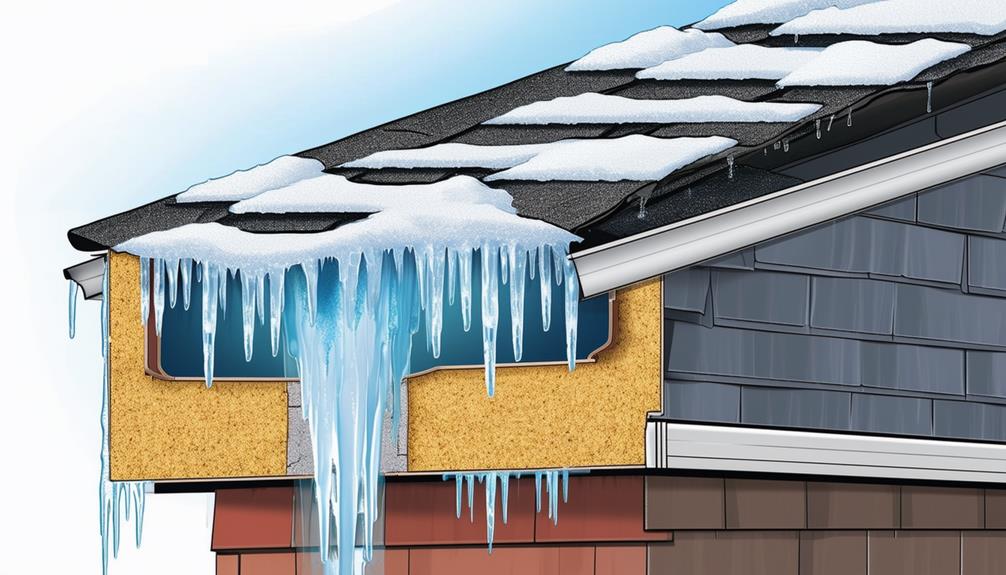
When it comes to roofing, understanding ice dams is essential. Ice dams are ridges of ice that form at the edge of a roof, preventing proper drainage. These dams can cause water to back up under shingles, leading to leaks and potential damage to the roof structure.
Definition of Ice Dam
Ice dams occur when melted snow refreezes at the edge of a roof, creating a barrier that prevents proper drainage. Here are some key points to help you understand ice dams:
- Formation: Ice dams form when the upper areas of the roof are above freezing temperature while the lower edge is below freezing, causing snowmelt to refreeze at the roof's edge.
- Consequences: If left unaddressed, ice dams can lead to water seeping under shingles, causing leaks, structural damage, and mold growth.
- Removal: Ice dams should be removed promptly to prevent water damage. This can be done through techniques like steaming, raking, or using calcium chloride to melt the ice.
- Repairs: After ice dam removal, it's important to inspect for any roof damage and address it promptly. This may involve replacing shingles, repairing flashing, or improving insulation to prevent future ice dams.
Understanding ice dams and taking proactive steps for their removal and repairs can help maintain the integrity of your roof and prevent costly damage.
Causes of Ice Dams
Understanding the causes of ice dams is essential for preventing potential roof damage and ensuring proper drainage. Ice damming effects occur when snow on the roof melts due to heat escaping from the attic, only to refreeze at the eaves where the roof is cooler. This refreezing creates a barrier that prevents proper water drainage, leading to water seepage under shingles and potential leaks. Roofing hazards associated with ice dams include structural damage, mold growth, and compromised insulation. Ice dam risks are heightened in regions with cold climates and frequent snowfall.
To prevent ice dams, consider improving attic insulation and ventilation to maintain a consistent roof temperature. Additionally, ensuring proper sealing of air leaks in the attic can help prevent heat loss, reducing the likelihood of ice dam formation. Regularly clearing snow from the roof can also minimize the buildup of ice dams and alleviate pressure on the roof structure. By understanding these causes and implementing prevention techniques, you can safeguard your roof against the damaging effects of ice dams.
Prevention Tips for Ice Dams
Implementing proper insulation and ventilation in your attic is crucial for effective prevention of ice dams on your roof. Ice dams form when heat escapes from the attic, causing snow on the roof to melt and refreeze at the eaves. To prevent ice dams, consider the following tips:
- Insulation: Make sure your attic is well-insulated to prevent heat from escaping and melting the snow on your roof.
- Ventilation: Proper ventilation helps maintain consistent attic temperature, preventing hot spots that lead to melted snow and ice dams.
- Roof Raking: Regularly remove snow from your roof using a roof rake to prevent excessive snow buildup that can contribute to ice dams.
- Ice Melting Products: Use ice melting products sparingly and according to manufacturer guidelines to deal with existing ice dams safely without causing damage to your roof.
Valley
A valley on a roof is a V-shaped area where two sloping roof planes meet, typically directing water towards the gutters. Valley construction plays an important role in guaranteeing proper water drainage and preventing leaks. Roofing materials like metal, asphalt shingles, or even rubber membranes are commonly used in valley construction to provide durability and protection against water infiltration.
For valley repair and maintenance techniques, it is essential to regularly inspect the valley for any signs of wear, such as cracked shingles, deteriorated sealant, or debris accumulation. Promptly addressing these issues can prevent water from seeping under the roofing materials and causing damage to the underlying structure. When repairing a valley, it is crucial to use compatible materials and ensure a watertight seal to maintain the roof's integrity.
Regular maintenance, including clearing debris and ensuring proper sealing, can extend the lifespan of the valley and contribute to the overall longevity of the roof. By understanding valley construction and implementing proper repair and maintenance techniques, you can help protect your roof from water damage and guarantee its functionality for years to come.
Frequently Asked Questions
How Can I Tell if My Roof Needs to Be Replaced?
To determine if your roof needs replacement, start with a thorough roof inspection. Look for signs like missing or cracked shingles, water stains on ceilings, or moss growth. Avoid DIY repairs that could lead to more significant consequences. If you notice multiple warning signs, it's best to consult with a professional roofer to assess the condition and discuss potential replacement options.
What Are the Different Types of Roofing Materials Available?
Imagine your home's roof as a crown with various jewels. For metal roofing, envision durability and modernity. Shingle options offer versatility and cost-effectiveness. Tiles bring elegance, while slate exudes luxury. Each material has unique benefits to fit your style and budget. Understanding the differences in metal, shingle, tile, and slate varieties can help you choose the best roofing material for your needs. Research and consult professionals to make an informed decision.
Are There Any Eco-Friendly Roofing Options?
When exploring eco-friendly roofing options, you'll find a range of green roofing materials designed for sustainability. These environmentally-conscious choices offer benefits like energy efficiency, reduced carbon footprint, and long-term cost savings. Opting for eco-friendly roofs can provide cost-effective solutions that contribute to a greener environment while enhancing the overall durability and performance of your roof. Consider these options for a more sustainable and budget-friendly roofing solution.
Is It Necessary to Hire a Professional for Roof Repairs?
When it comes to roof repairs, it's often said, "Measure twice, cut once." While some DIY repairs can be manageable, hiring a professional for roof repairs is usually necessary. Professionals offer expertise, ensuring the job is done correctly and safely. Though it may seem like a cost-saving measure to tackle repairs yourself, improper fixes can lead to more significant issues down the line, potentially costing you more in the long run.
What Factors Affect the Cost of a New Roof?
When considering the factors influencing the cost of a new roof, roofing material comparison is vital. The type of material chosen, such as asphalt shingles, metal, or tiles, greatly impacts pricing. Additionally, implementing cost-saving strategies like scheduling repairs during off-peak seasons, bundling services, or opting for energy-efficient materials can help manage expenses. Understanding these elements will guide you in making informed decisions to guarantee a cost-effective roofing project.
Conclusion
Now that you've familiarized yourself with the roofing terminology glossary, you're ready to tackle any roofing project with confidence. Understanding the lingo is like having a map to navigate the world of roof construction – it guides you through the twists and turns, ensuring a successful journey to a secure and well-built roof. Embrace the knowledge you've gained and watch your roofing skills soar to new heights! With your newfound expertise, you can now dive into detailed roofing project studies to further enhance your understanding and refine your skills. These studies provide insights into advanced techniques, material selection, and best practices that set professional roofers apart. By continuously building on your knowledge base, you’ll be well-equipped to handle challenges and deliver high-quality results in every roofing endeavor.




